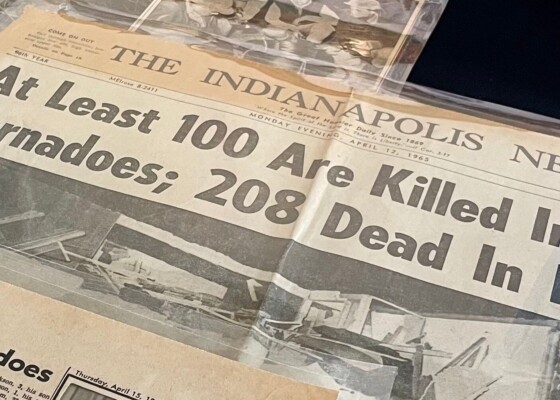Why We Chose The Year We Left Home
March 12, 2019In Jean Thompson’s 2011 novel The Year We Left Home, Ryan, a main character, reflects, “But back home, I can look up and down just about any street and there’s…
In Jean Thompson’s 2011 novel The Year We Left Home, Ryan, a main character, reflects, “But back home, I can look up and down just about any street and there’s people I’m either related to or I’ve known them all my life and my parents have known them and my grandparents knew their grandparents and there’s a comfort in that. I miss it. That’s all I’m saying. Here [in the city], it’s like we’re not from anywhere.”
This spring, Indiana Humanities launched our newest thematic initiative, INseparable, which asks Hoosiers to consider what unites and divides us across urban, rural and suburban lines. Over the next two years, we’ll offer programs and grants that invite Indiana residents to explore ideas about urban, rural and suburban America. We’re curious about the history of these terms and these spaces. We also wonder to what extent there is a divide, or if these divisions are a matter of perception.
One State / One Story is a statewide program which provides program support and funding to organizations to engage in conversations about a common text. For our second One State / One Story, our goal was to select a book that spoke to the themes of INseparable. We wanted a text that told stories of individuals crossing boundaries to encourage Hoosiers to think, read and talk about how the futures of urban, rural and suburban Hoosiers are linked, and what might be preventing us from working together.
Unsurprisingly, there are few contemporary novels that address the urban/rural divide directly. Often in literature, the urban is figured as the opposite of the rural, and vice versa. Characters in novels escape from the busy, dirty, blighted city to idyllic, pastoral rural lands. Or, in other stories, farm kids leave stagnant, small towns and head to the bustling city, a symbol of progress and the American Dream. William Cronon, in his ground-breaking work Nature’s Metropolis, suggests the dialectical, oppositional ways urban and rural are typically framed in literature: “At journey’s end stood a city that represented the geographical antithesis of the lands around it, and the historical prophecy of what America might become as it escaped its rural past.”
Surely, the reality of our experiences of urban and rural is more complicated than this.
Jean Thompson’s 2011 novel, The Year We Left Home, offers a more complex view of rural, urban and suburban experiences in the American Midwest. Beginning in Iowa in 1973, the novel follows the Erickson family through the many changes affecting American life at the end of the twentieth century. From city rooftops to country farms, college campuses to small-town main streets, the characters in Thompson’s novel search for fulfillment and happiness in an ever-changing, often alienating country. The story asks us to consider the enduring, uniting power of place – why we choose or are forced to leave and when we decide to come home.
The Year We Left Home, a New York Times Bestseller and finalist for the National Book Award, is a comprehensive, multivocal testament to the many ways we experience urban and rural spaces today. The book evokes many questions important for us to consider: How do we connect to place and what makes a “home”? To what extent is the American Dream available to all citizens, and why are others turned away? How did national and international policies and events like the Vietnam War, the 1980s Farm Crisis, or 9/11 affect communities and individuals? How do we confront change and find the strength to persist?
We also think The Year We Left Home is a sterling example of the recent wave of literature by Midwestern authors about Midwestern experiences. Some might say we’re living through a new golden age of literature from the heartland, a provocative idea we hope to explore over the next two years with you. (Get started by attending our panel with Cathy Day, Deborah E. Kennedy and Adrian Matejka about the state of Indiana literature today at IU’s upcoming Gran Falloon festival.)
During 2020, we’ll consider these rich questions and ideas using The Year We Left Home as our starting point. As we did with Frankenstein, we’ll offer a variety of resources and coordinate events across the state to get Hoosiers to think, read and talk about our One State / One Story selection, in partnership with the Indiana State Library and Indiana Center for the Book. Indiana Humanities will release a program guide in the fall of 2019 and open applications for Community Read ($750 + books and promotional materials) and Campus Read (up to $4,000) grants to support programs in 2020. Additionally, an in-depth Weekend Retreat during the spring of 2020 will give readers the opportunity to dive deep into the book with scholars and others passionate about literature. Read more about the programs available through One State / One Story.
We are excited to read, think and talk with you about The Year We Left Home during 2020. If you’d like to get updates when programs and events are announced, sign up for our newsletter below.
About INseparable
Whether due to real or perceived differences, Americans see each other differently depending on whether they live in rural, suburban or urban communities. The conclusion drawn from the near-constant polling, media commentary, and academic analysis of the past two years is that America is culturally divided by its geography. In 2019 and 2020, Indiana Humanities invites Hoosiers to dig into these divides, exploring how Hoosiers relate to each other across boundaries and considering what it will take to indeed be inseparable, in all the ways that matter.


